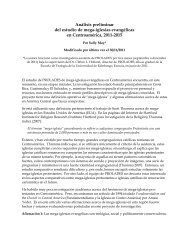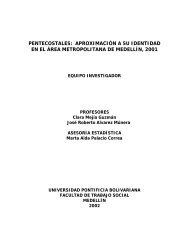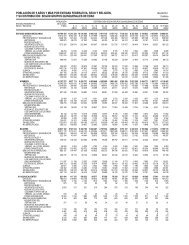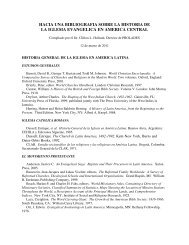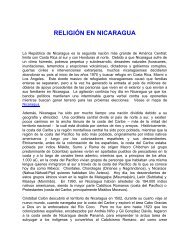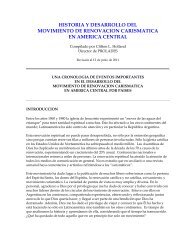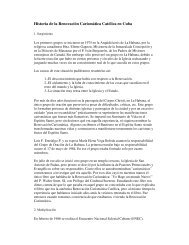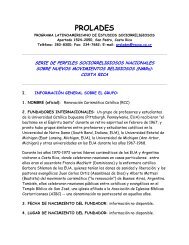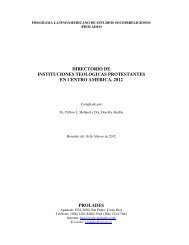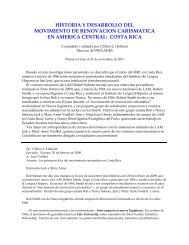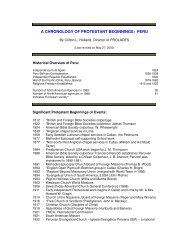belize, 1980 - Prolades.com
belize, 1980 - Prolades.com
belize, 1980 - Prolades.com
Create successful ePaper yourself
Turn your PDF publications into a flip-book with our unique Google optimized e-Paper software.
while others were in Spanish, to meet the language needs of those attending. Hopefully, this new<br />
strategy of ministry will encourage other pastors and churches to take language and cultural<br />
differences into greater consideration as they seek to evangelize and disciple the peoples of Belize<br />
for Jesus Christ.<br />
Another example of this strategy is that of Tom Pound, who moved to the Toledo District to<br />
work among the Mopan Maya and Kekchí Indians. These two language groups live in some two<br />
dozen villages scattered all over a large area of tropical rain forest in southern Belize. Here, a multilingual<br />
situation exists, since older peoples usually speak their Indian languages in addition to some<br />
Spanish, while the younger ones are learning to speak English in the public schools. After four<br />
years of visiting these isolated villages and winning friends among the people, Pound was able to<br />
organize five Nazarene churches. He attributes his success to a specific strategy that God blessed:<br />
Pound concentrated his evangelistic efforts on winning the key male leadership in each village,<br />
because the family unit is very strong, and the father is the head of the household. When these key<br />
<strong>com</strong>munity leaders were converted, they became the lay pastors in their respective villages. Pound<br />
established an Educational Center in a central location under local administration, where weekend<br />
training classes were offered for the growing number of new converts. Reports in 1978 seem to<br />
indicate that a "people movement" was occurring among Mopan Maya and Kekchí peoples in this<br />
region.<br />
However, only 18 organized churches and missions were reported in 1978 by the Nazarenes<br />
in Belize, with 632 <strong>com</strong>municant members, although the total Nazarene <strong>com</strong>munity was estimated to<br />
be about 2,500. Nazarenes are mainly located in the Districts of Cayo, Stann Creek and Toledo.<br />
5.1.8 The nondenominational Gospel Missionary Union (Kansas City, MO) sent their<br />
missionaries to Belize in 1955. The Gordon Lees settled in Belize City where they established the<br />
Yarborough Bible Church. In 1956, the Mission acquired a 20-acre tract of land about 30 miles from<br />
Belize City, where they opened a camping and conference center and a Bible school known as<br />
Carol Farm. Ministry was initiated among the Yucatec Maya in Orange Walk District in 1960, and a<br />
Christian bookstore was begun in Belize City a few years later. By 1978, there were seven<br />
organized churches and five mission stations with 326 baptized members.<br />
5.1.9 The Anabaptist-Mennonite Movement began in the early 1500s in Switzerland, Holland<br />
and Germany, where religious persecution resulted in significant migrations of Mennonites to many<br />
continents and within many countries of the world. Mennonites first came to Belize between 1958<br />
and 1962 from Mexico, where they had established agricultural colonies during the 1920s and<br />
1940s, chiefly to preserve their unique way of life from the corrupting influences of modern society,<br />
and specifically to maintain the right to operate their own schools in their own language, the German<br />
dialect Plattdeutsch (also known as Low German).<br />
In 1958-1959, two groups of Old Colony Mennonites (Altkolonier Mennonitengemeinde)<br />
moved from the State of Chihuahua in Mexico to Orange Walk District in Belize because of the<br />
difficulties with the Mexican government. In Belize, they created the Blue Creek and Shipyard<br />
Colonies. The Mennonite immigrants included 360 families, totaling 1,627 persons (including 775<br />
children under 14 years of age). Later, a small group from Shipyard relocated to the town of Little<br />
Belize in Corozal District. Also, in 1959, a group of Little Brotherhood (Kleinegemeinde)<br />
Mennonites from Mexico established a colony at Spanish Lookout in Cayo District. Amish, Old<br />
Colony and Kleinegemeinde families settled in the Barton Creek Colony. After Hurricane Hattie<br />
devastated parts of Belize in 1961, several other Mennonite agencies helped with disaster relief,<br />
including the Beachy Amish who have continued to work in Belize. The Mennonite Central<br />
51



